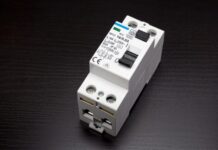In this PowerVersity guide, Victor answers the question, “How do circuit breakers work”
The guide starts by explaining What a circuit breaker means. It then discusses the workings, types, and what you need to know about the operation of an inverter.
We have all experienced it in one way anotherher. Your daughter is ironing a blouse, and your wife is blow-drying her hair.
Moreso, your home carer also decided to refill the used water in the water tank by switching the pumping machine. However, for you, all you want is some toasted bread.
After inserting the bread and depressing the toaster’s handle, there is an audible quiet that indicates that all of your home’s electrical systems have stopped working.
What!!! Don’t worry about yourself. “The safety boss” – circuit breaker is at work.
You may despise your home and blame the toaster, but the tripped circuit that just cut out your power was only doing its job.
Any given circuit breaker in your home has only two functions: to safeguard the electrical wiring there and to keep you safe.
When your home’s cables are overloaded with electrical current and begin to heat up, that protection kicks in.
The circuit breaker trips as opposed to the heat being distributed to the electrical devices and appliances hooked into your outlets, which could result in them burning out and possibly starting a fire.
This turns off the energy at its distribution point for the entire house or just that particular zone.
Relax!!! Now that you have a little knowledge of how circuit breakers work, let us go into the details
Read through to find all the necessary details you need to know about the circuit breaker.
Expand “Browse Post Topics” below to go straight to a topic.
What is a Circuit Breaker?
This electrically powered switch is intended to prevent a short circuit or overload from damaging the circuit.
To avoid unexpected power accidents that could result in unsafe household appliances, the circuit breaker instantly disconnects in the event of instability in the power flow.
Consequently, a circuit breaker is a crucial piece of equipment and one of the most crucial safety features to have at home or even at your place of employment.
How Does A Circuit Breaker Work?
A power plant generates electricity, which is then delivered to every home. The electricity travels through a major circuit, which is made up of numerous smaller circuits.
The circuit’s hot wire (one end) connects to the power source, and the neutral wire (the other end) connects to the ground.
The so-called hot wire is connected to a high-energy source, while the neutral wire is connected to the ground, which is an electrically neutral source.
Of course, there is the voltage across the circuit, and anytime the circuit is closed, the charge moves. Because of its frequent or abrupt direction changes, this current is referred to as an “alternating current”.
The charge flowing through the circuit passes through an appliance that serves as a resistor in building wiring. Hence, preventing the neutral wire and hot wire from ever coming into direct contact.
As a result, the amount of charge that may pass across a circuit is limited by the electrical resistance in the equipment. For safety reasons, appliances are well built so that they maintain current at a minimal level.
When a circuit’s charge flow is excessive at one time, the wiring of the building and the wires used by the appliances would be heated to a dangerous degree, which would likely result in the start of a fire.
Then the need for circuit breakers arises.
Why A Circuit Breaker Is Necessary
Herein lies the function of a circuit breaker; anytime the current exceeds a safe level, it shuts off the circuit.
The simplest form of circuit protection, a fuse is only a small wire encased in a casing that plugs into the circuit.
This is how it functions:
When a circuit is closed, the charge passes through the fuse wire.
The fuse receives the same amount of current as every other point in the circuit, and when it warms up to a hazardous level, the fuse breaks apart as it is intended to do.
When the currents are excessively high, the wire burns out, blowing the fuse and cutting off the circuit before the extra current damages the building’s wire.
A straightforward switch coupled to either an electromagnet or a bimetallic strip makes up the fundamental circuit breaker. The two ends of the switch are connected via the circuit’s hot wire.
When the switch is in the ON state, electricity can move from the lower terminal to the upper terminal via the electromagnet, the moving contact, and then across to the stationary contact.
Now, let us see the types of circuit breakers available in the market.
How Do Circuit Breakers Work: Types Of Circuit Breakers
To achieve the desired performance, circuit breakers come in a variety of designs. Here are some fundamentals of the circuit breaker. These include:
-Thermal
-Thermal Magnetic
-Magnetic
-Magnetic with hydraulic delay
Thermal Circuit Breaker (TCB)
For the protection of transformers and motors against current overload, this circuit breaker is particularly ideal.
Due to the internal bimetal’s thermal inertia, which is brought on by the current flow that heats it, the breaker trips when the bimetal is deflected.
Being less sensitive to the rushing-in currents brought on by the start-up of motors and transformers is one of the benefits of thermal circuit breakers for equipment.
Thermal Magnetic (TMCB)
These circuit breakers are a hybrid of magnetic and thermal breakers. Solenoid release mechanisms are triggered simultaneously by very high currents and the thermal mechanism reacts to protracted low-value overloads.
It is distinguished by a two-step trip profile that quickly protects expensive electrical systems against short circuits while minimizing the danger of system disruption.
Magnetic Circuit Breaker (MCB)
The moment the safe current limit is surpassed, this product trips very quickly.
The solenoid’s use of electromagnetism to move the internal armature and open the connections is crucial in this situation. PCBs typically employ magnetic CB.
Magnetic With Hydraulic Delay
As the name suggests, the type of circuit breaker is combined with hydraulic delay to make it current tolerant.
The piston will move up or down depending on the current flowing through the coil, and if the rated current is exceeded, the piston will travel beyond that point.
The electromagnetic force will be powerful enough to move the armature once the piston is close enough to the “Pole piece” to do so. This opens the contact.
The hydraulic delay used in this sort of CB and in hydraulic delay breakers is the same. The delay will be longer the heavier the viscosity.
In order to prevent gravity from affecting the solenoid’s movement, this CB is installed horizontally.
Specifications Of The 5 Best Selected Circuit Breakers
| Product Name | Dimensions | Item Voltage | Current | Mounting Type | Brand |
| 12V-110V DC – Miniature Circuit Breaker | 2.96 x 1.41 x 3.26 inches | 36 Volts, 48 Volts, 24 Volts, 12 Volts | 10 Amps | Nil | CHTAIXI |
| Suntree 32 Amp Single-Pole DC | 3.2 x 3 x 0.7 inches | 32 Amps | DIN Rail Mount | Renogy | |
| EPLZON 200A Circuit Breaker Resettable | 4.37 x 3.03 x 2.13 inches | 24 Volts, 12 Volts | 200 Amps | Panel Mount | EPLZON |
| Chtaixi AC Miniature Circuit Breaker | 2.95 x 0.7 x 3.15 inches | 240 Volts | 20 Amps | DIN Rail Mount | CHTAIXI |
| Westinghouse Miniature Circuit Breaker | 4.33 x 3.27 x 0.94 inches | 277 Volts | 15 Amps | DIN Rail Mount | Westinghouse |
Circuit Breaker FAQ

1. Where is the circuit breaker located in the house?
Circuit breakers are typically found in low-traffic parts of the house, such as a basement, garage, or utility closet, however, every property is unique. If you live in an apartment, your circuit breaker can be in a more accessible spot, such as the laundry room or hallway.
2. What causes MCCB to trip?
The simple answer to this is Overloaded circuit
The most frequent cause of circuit breaker tripping is understood to be circuit overloading. It simply means that we are using too many large, power-hungry devices on the same circuit at once.
3. Why do we use MCCB instead of MCB?
While MCCBs are utilized for circuits with strong currents, MCBs are frequently employed in circuits with low circuit currents. The MCCB is utilized in areas with high energy requirements (big businesses), whereas the MCB is used in areas with moderate energy requirements (domestic purposes).
4. How many amps is a main breaker?
Most domestic circuits are typically rated at 15 amps or 20 amps. It’s crucial to keep in mind that circuit breakers are only capable of handling roughly 80% of their total amperage. Thus, a 20-amp circuit breaker can withstand roughly 16 amps, compared to a 15-amp circuit breaker’s capacity of about 12 amps.
5. What is a main fuse?
The electrics in your home are intended to run and be protected by a mains fuse box, often known as an electricity board or fuse board. It’s crucial that you know where your fuse box is because it’s a crucial component of your kit that will safeguard you in case of an electrical emergency.
6. Why does MCB trip when AC is on?
As a result of drawing more amps than the breaker is designed to handle, an air conditioner typically trips the breaker. That is, if your breaker is rated for 20 amps and your AC uses 30 amps, your breaker will trip. Breakers trip for this reason—to shield you from overcurrents that could harm your property and start flames.
7. How do you calculate breaker size?
Divide the modified wattage by 240 volts to determine the subpanel’s required rated amperage. This will help you determine the size of the breaker. Common circuit breaker sizes are frequently not the outcome. rounded up to the breaker’s next larger size is also an option. You should install a 60-amp breaker to safeguard the circuit, for instance, if the load calculation results in 56 amps. A double-pole circuit breaker is necessary for the feeder circuits that supply subpanels because they are 240 volts.
8. Can AC run without MCB?
The simple answer is yes. However, avoiding uncomfortable situations and having more confidence that your electrical system isn’t being overworked are both possible benefits of having your air conditioner on its own breaker.
9. How many amps is a MCCB?
The maximum current that a circuit should draw is what is known as the rating current, and it ranges from 10 to 200 amps for an MCCB. MCCBs are usually utilized in circuits with high currents. In demanding industrial applications, they are frequently used.
10. What happens if MCB is overloaded?
The bimetallic strip is heated by the electrical charge and bends during a slow continuous over-current, which is a hallmark of overload, releasing the mechanical lock. The operating mechanism’s latch, which is attached to the contacts, opens the connections and interrupts the circuit.
My Final Thoughts On How Circuit Breakers Work
That’s it on “How Do Circuit Breakers Work”
I hope you found this PowerVersity pick helpful.
If you found it helpful, kindly share your thoughts with the “Leave a Reply” form found towards the end of this page.
Finally, to read more guides like this, visit the following pages.
Best Circuit Breaker: Better Fuse or MCB in the Market




